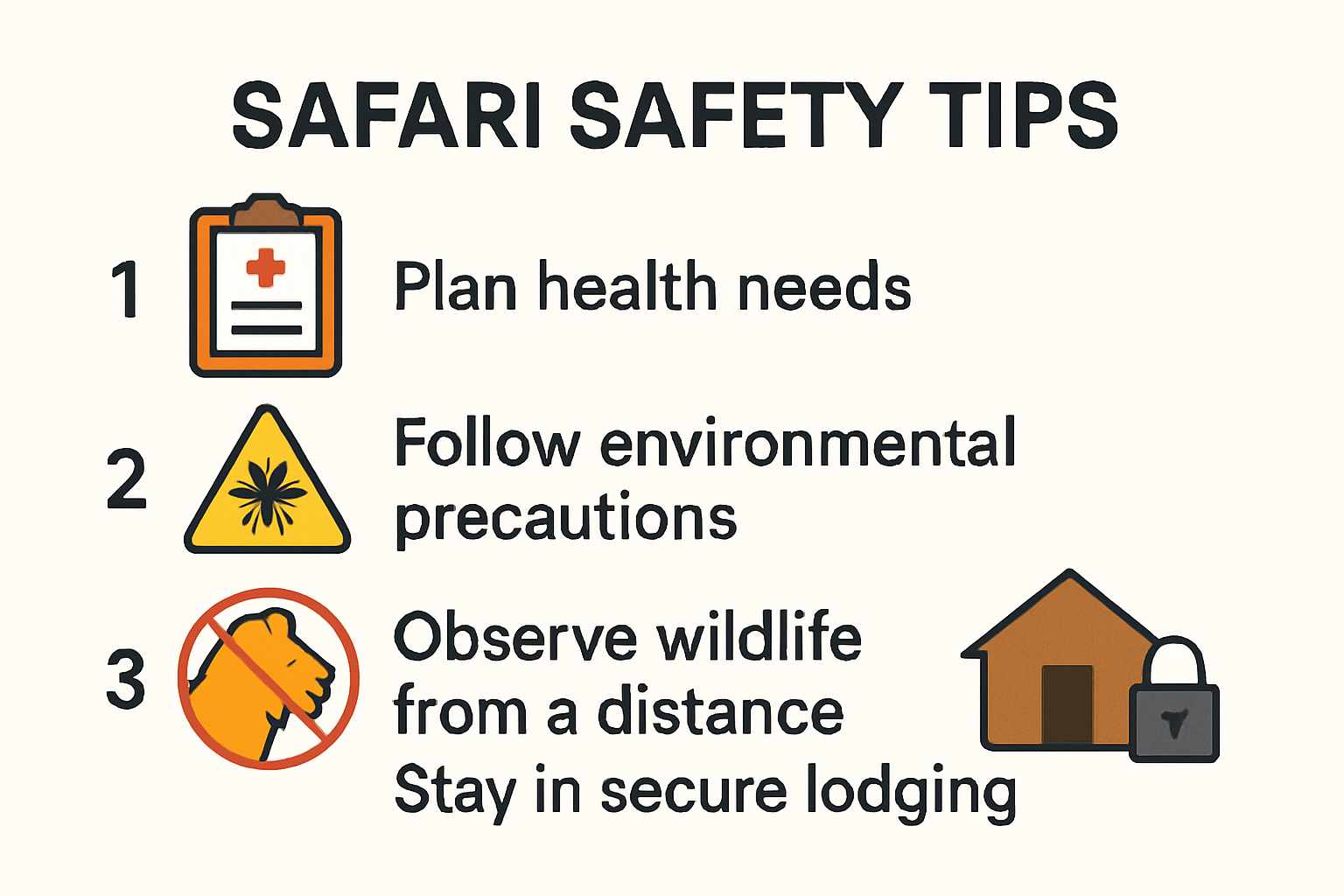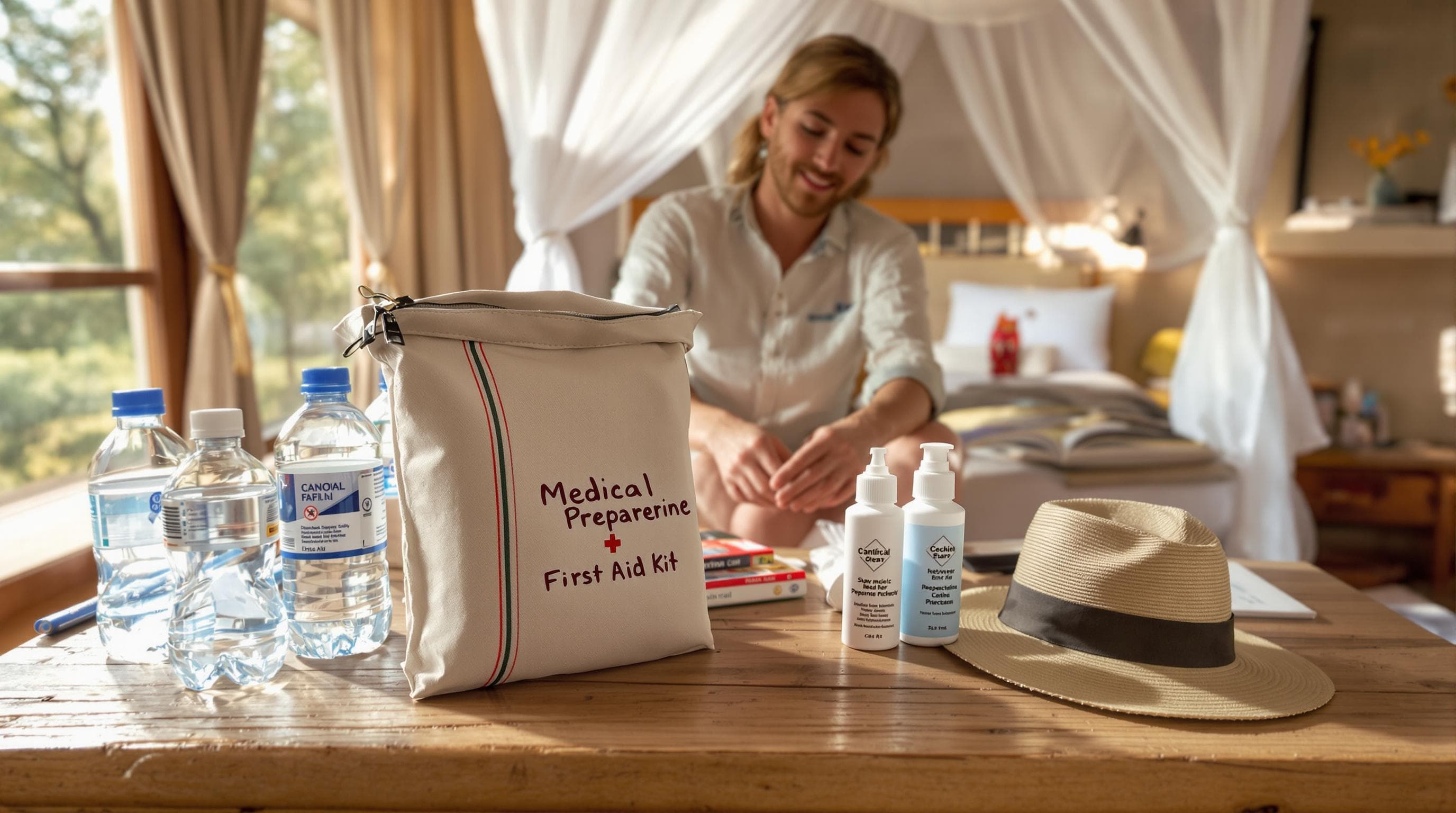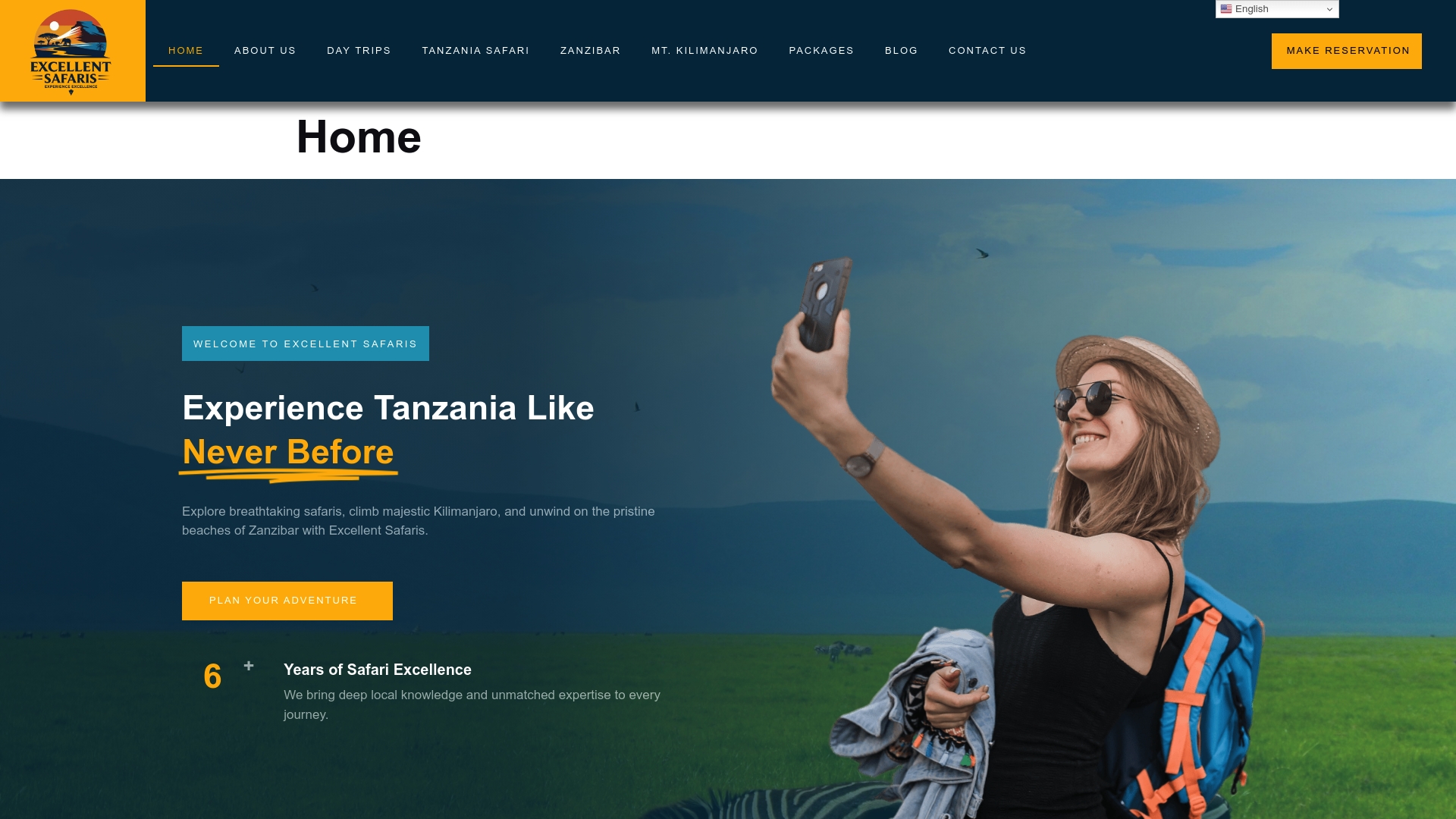Safari travel is set to surge in 2025, drawing thousands of adventurers eager for extraordinary wildlife encounters. Here is something many travelers overlook. Over 70 percent of safari incidents happen because visitors ignore basic safety protocols. Avoiding disaster is less about luck and more about smart, simple choices you make long before you ever see a lion or elephant.
| Takeaway | Explanation |
|---|---|
| Consult a healthcare provider before travel | Engage with a healthcare professional 6-8 weeks prior to departure for necessary vaccinations and tailored medical advice for your safari itinerary. |
| Follow safety protocols during wildlife encounters | Maintain a safe distance from wildlife—typically at least 75 feet—and always heed your guide’s instructions to ensure both your safety and that of the animals. |
| Stay hydrated and protect against environmental hazards | Carry adequate water and electrolyte solutions, wear protective clothing, and utilize sunscreen to mitigate the risks associated with heat exposure and insect bites. |
| Secure your lodging and personal space | Keep tent or lodge entrances closed, store food securely, and familiarize yourself with the emergency procedures upon arrival to ensure safety during your stay. |
| Practice responsible wildlife photography | Use telephoto lenses to maintain distance while photographing and avoid flash to prevent startling animals, contributing to both animal safety and ecological respect. |
Preparing for a safari adventure requires strategic planning and comprehensive understanding of potential challenges. Your safety begins long before you set foot on African terrain, with careful preparation serving as the foundation for an extraordinary and secure wildlife experience.

Prioritizing your health is critical when planning a safari. Travelers should consult a healthcare provider 6-8 weeks before departure to ensure comprehensive medical preparation. This consultation involves obtaining necessary vaccinations that protect against region-specific diseases. Learn more about our recommended travel health protocols.
According to the Centers for Disease Control and Prevention, essential vaccinations include hepatitis A and B, typhoid, tetanus, and yellow fever. Malaria prophylaxis is also crucial for travelers visiting endemic areas. Your healthcare professional can provide personalized recommendations based on your specific travel itinerary and medical history.
Beyond vaccinations, consider comprehensive travel insurance that covers medical evacuation. Remote safari locations may have limited immediate medical access, making robust insurance coverage a critical safety net. Carry a well-stocked medical kit containing personal medications, basic first aid supplies, anti-diarrheal medication, rehydration salts, and treatments for potential insect bites.

Safari environments present unique challenges that require careful preparation. Research from CDC travel guidelines recommends wearing protective clothing and using broad-spectrum sunscreen with SPF ≥15 to prevent sun-related health risks.
Pack lightweight, long-sleeved shirts and long pants in neutral colors like khaki, beige, and olive green. These colors help you blend into the natural environment and provide protection against sun exposure and insect bites. Wide-brimmed hats, sunglasses, and sturdy closed-toe walking shoes are essential. Consider moisture-wicking fabrics that offer breathability in hot climates.
Stay hydrated by carrying sufficient water and electrolyte replacement solutions. Dehydration can occur rapidly in safari environments, potentially leading to heat exhaustion or more serious health complications. Aim to drink at least 3-4 liters of water daily, adjusting intake based on temperature and activity levels.
Understanding and adhering to safety protocols is non-negotiable during a safari. Always follow your professional guide’s instructions and maintain a safe distance from wildlife. According to wildlife conservation experts, unpredictable animal behavior requires constant vigilance and respect for natural habitats.
During game drives, remain inside the vehicle unless explicitly instructed otherwise by your experienced guide. Sudden movements or loud noises can startle animals, potentially triggering defensive responses. Binoculars allow you to observe wildlife closely without compromising safety. Always listen to your guide’s directions and maintain a calm, quiet demeanor.
By implementing these comprehensive safety strategies, you transform potential risks into manageable elements of an unforgettable safari experience. Preparation, awareness, and respect for the natural environment are your most valuable companions on this extraordinary journey.
To help you plan medical preparations more effectively, the table below summarizes the key medical requirements and health recommendations discussed above.
| Medical Preparation Step | Details/Examples |
|---|---|
| Pre-travel healthcare consultation | 6-8 weeks before departure; customized advice for itinerary and health history |
| Required vaccinations | Hepatitis A & B, typhoid, tetanus, yellow fever |
| Malaria prophylaxis | As advised for endemic safari destinations |
| Comprehensive travel insurance (with evacuation coverage) | Ensures access to care in remote areas, covers medical emergencies |
| Well-stocked medical kit | Personal prescriptions, first aid supplies, anti-diarrheals, rehydration salts |
Wildlife encounters represent the pinnacle of safari experiences, offering intimate glimpses into the raw beauty of natural ecosystems. However, these moments demand precise understanding, respect, and strategic behavior to ensure both human safety and animal welfare.
Successful wildlife encounters begin with fundamental respect for animal territories and natural behaviors. Research from wildlife conservation experts emphasizes maintaining a safe distance to prevent provoking defensive responses. Professional safari guides recommend staying at least 75 feet away from most wildlife, creating a buffer zone that protects both humans and animals.
Never attempt to approach, touch, or feed wild animals. According to National Geographic wildlife experts, feeding disrupts natural foraging behaviors and can create dangerous dependencies. Wild animals have complex ecological roles, and human intervention can significantly alter their survival mechanisms. Your role as a responsible traveler is to observe, not interact.
During wildlife encounters, your demeanor becomes critically important. Healthcare professionals specializing in wildlife safety recommend maintaining calm and avoiding sudden movements. Loud noises, rapid gestures, or panicked reactions can trigger defensive instincts in animals, potentially escalating dangerous situations.
Practice quiet observation techniques. Use binoculars to view animals closely without physical proximity. Move slowly and deliberately if movement is necessary. Professional guides often instruct travelers to maintain a low profile, minimize direct eye contact with predators, and remain within vehicle boundaries during game drives. These strategies help prevent misinterpreting animal signals and reduce potential confrontational scenarios.
Photographing wildlife requires a nuanced approach that prioritizes animal welfare over capturing the perfect shot. Use telephoto lenses that allow significant distance between you and the subject. Disable camera flash functions, as sudden bright lights can startle or disorient animals. Be patient and wait for natural moments to unfold rather than attempting to manipulate animal behavior for photographic purposes.
Remember that each wildlife interaction represents an opportunity to learn and appreciate complex ecological systems. By practicing respectful observation, you contribute to conservation efforts and sustainable tourism practices. Your restraint and awareness protect not just yourself, but the delicate balance of wildlife habitats.
Ultimately, successful safari experiences are defined by mutual respect between humans and the extraordinary creatures inhabiting these magnificent landscapes. Approach each encounter with humility, curiosity, and an understanding that you are a guest in their intricate, wild world.
Below is a checklist table for responsible wildlife interaction principles to reinforce safe and respectful behaviors during wildlife encounters.
| Action | Recommended? |
|---|---|
| Maintain safe distance (at least 75 feet) | Yes |
| Approach or touch wild animals | No |
| Feed animals | No |
| Use binoculars for observation | Yes |
| Move quietly and avoid sudden gestures | Yes |
| Minimize direct eye contact with predators | Yes |
| Remain within vehicle boundaries | Yes |
Navigating health challenges during a safari requires strategic preparation and comprehensive understanding of potential medical risks. Your ability to anticipate and manage health concerns can transform potential medical complications into manageable experiences.
Preparing a robust medical strategy begins with consultation and comprehensive planning. Johns Hopkins Medicine recommends creating a detailed travel health kit tailored to safari environments. This kit should include personal prescription medications, over-the-counter pain relievers, antihistamines, antiseptic wipes, multiple sizes of sterile bandages, tweezers, and compact medical tools.
According to CDC travel guidelines, travelers must prioritize preventative medications and vaccinations. Consider prescription medications for potential issues like altitude sickness, traveler’s diarrhea, and motion sickness. Pack these medications in original, clearly labeled containers and carry copies of prescriptions to facilitate potential international medical interactions.
Traveler’s diarrhea represents a significant health risk in safari environments. Centers for Disease Control recommendations emphasize strict protocols for food and water consumption. Always drink bottled or thoroughly purified water. Avoid ice cubes, uncooked vegetables, and street vendor foods that might compromise your digestive health.
Implement rigorous hand hygiene practices. Carry alcohol-based hand sanitizers containing at least 60% alcohol when soap and water are unavailable. Use sanitizing wipes to clean eating utensils and surfaces. Consider packing oral rehydration salts to manage potential dehydration resulting from gastrointestinal issues.
Safari environments present unique health challenges beyond typical travel concerns. Protect yourself against insect-transmitted diseases by using EPA-registered insect repellents containing DEET. Wear long-sleeved shirts and long pants during dawn and dusk when mosquitoes are most active. Travel health experts recommend treating clothing and gear with permethrin for additional protection.
Manage potential heat-related illnesses by staying hydrated and recognizing early signs of heat exhaustion. Symptoms include heavy sweating, weakness, dizziness, and headaches. Carry electrolyte replacement solutions and seek shade during peak temperature hours. Wear lightweight, breathable clothing in light colors that reflect sunlight and help regulate body temperature.
Remember that proactive health management is your primary defense in remote safari environments. Your preparedness transforms potential medical challenges into manageable experiences, allowing you to focus on the extraordinary wildlife and landscapes surrounding you. Approach your safari with confidence, knowing you’ve equipped yourself with knowledge and essential medical resources.
Safari camps and lodges represent your sanctuary in the wilderness, offering a delicate balance between immersive natural experiences and essential safety. Understanding the nuanced security protocols specific to these unique environments ensures a comfortable and protected stay.
World Nomads travel safety experts emphasize the critical importance of guided movement during nighttime hours. Always request an escort when traveling between accommodations and common areas after dark. Wild animals like hippos, elephants, and predators are most active during twilight and nighttime hours, making unaccompanied walking extremely dangerous.
Most safari lodges provide trained staff members who understand animal movement patterns and can safely guide guests. These professionals are equipped with flashlights and knowledge of local wildlife behaviors. Follow their instructions precisely, maintain a close proximity, and avoid wandering independently. Silent, slow movements are essential to prevent startling nearby wildlife.
Protecting your living space requires meticulous attention to detail. Safari safety guidelines recommend keeping tent or lodge entrances securely closed to prevent unwanted wildlife intrusions. Inspect your accommodation for potential entry points and ensure windows, doors, and screens are intact before settling in.
Store food items in sealed containers and never keep edibles inside your sleeping quarters. The aroma of food can attract dangerous wildlife, from small rodents to larger predators. Most lodges provide secure storage areas or in-room safes for valuables. Use these facilities to protect personal items and maintain a clean, uncluttered living space that does not inadvertently invite animal curiosity.
Africa Geographic safety recommendations highlight the importance of establishing clear communication protocols within your safari camp. Upon arrival, familiarize yourself with emergency procedures, evacuation routes, and communication systems. Many lodges provide emergency communication devices or designated staff members trained in rapid response scenarios.
Carry a charged mobile phone or satellite communication device, though coverage may be limited in remote areas. Learn basic emergency signals used by your lodge or tour operator. Some camps utilize specific whistle codes or radio communication methods for guest safety. Understanding these systems can be crucial during unexpected wildlife encounters or medical emergencies.
Remember that your safety in safari camps depends on a combination of professional guidance, personal awareness, and respectful interaction with the surrounding environment. By following established protocols and maintaining situational awareness, you transform potential risks into manageable experiences. Your lodging becomes not just a place of rest, but a secure base from which to explore the magnificent wilderness surrounding you.
Prioritize your health by consulting a healthcare provider 6-8 weeks before your trip for necessary vaccinations. Carry a well-stocked medical kit, stay hydrated, and familiarize yourself with safety protocols before embarking on your adventure.
Always maintain a safe distance of at least 75 feet from wildlife and listen to your guide’s instructions. Avoid approaching, touching, or feeding animals to respect their natural behaviors and reduce risks.
Key health precautions include obtaining required vaccinations, carrying water purification methods, practicing good hygiene, and using insect repellents to prevent diseases like malaria and other insect-borne infections.
Keep tent or lodge entrances securely closed, store food in sealed containers, and learn the emergency protocols provided by your lodge upon arrival to ensure safety from wildlife encounters.
Every traveler dreams of adventure, but real confidence comes from knowing you are fully prepared for the unexpected. This article uncovered just how quickly a magical safari can turn risky if you neglect safety steps, overlook essential health preparations, or feel uncertain about campsite protocols. When facing new environments, trust and support matter most.

At Excellent Safaris, we turn safety advice into personal action. Our team will help you secure necessary travel health precautions, brief you on wildlife interaction rules, and ensure your camps and lodges follow the latest safety standards. Whether you need customized itineraries with built-in security or want expert guidance on vaccines and local support, we cover every detail. Book now to travel smarter, stay protected, and fully immerse yourself in the beauty of Tanzania. Your safest and most memorable safari starts by planning with real professionals. Visit Excellent Safaris to get started today.
WhatsApp us